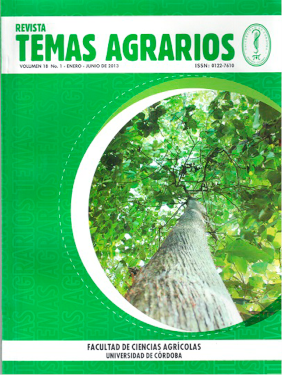Effectiveness of the implementation of coffee wastewater biosupplies in productivity of vegetables
Efectividad de la aplicación de bioinsumo de aguas residuales de café en productividad de hortalizas

This work is licensed under a Creative Commons Attribution-NonCommercial 4.0 International License.
Show authors biography
Colombia’s coffee is characterized by its organoleptic quality, but the humid beneficiary process constitutes a problem because of the amount of water used and the pollution generated by products as solid waste and wastewater, creating ecological imbalances and health problems. This project was intended to test the effectiveness of the wastewater treated with coffee leachate from coffee pulp inoculated with efficient microorganisms (EM), used as biosupplie for the production of radish Raphanus sativus and cucumber Cucumis sativus. Some tests were carried out to evaluate the appropriate biosupplie volumetric dosage that presents the best productivity rates in radish. Five treatments with three repetitions were made. Once the ideal dosage was determined, it was compared with a synthetic chemical fertilizer in an experiment of three treatments and three repetitions in cucumber. The results show that the most suitable dosage of wastewater treated with ME as biosupplie to be used in radish and cucumber was 30 cm3 L-1; likewise, significant differences in cucumber production when compared the biosupplie with control group were found. It is expected that the use of efficient microorganisms could be an environmentally sustainable alternative for decontamination of water and improving the agricultural productivity
Article visits 1220 | PDF visits
Downloads
- Criollo, H. y GarcÌa, J. 2009. Efecto de la densidad de siembra sobre el crecimiento de plantas de rábano (raphanus sativus L.) bajo invernadero. Revista Colombiana de Ciencias hortícolas 3(2):210-222.
- Delgado, Y. 2009. Evaluación de microorganismos eficientes en el cultivo de tomate (Lycopersicon esculentum Mill) en el organopónico de la Universidad de Matanzas. http://monografias.umcc.cu/ monos/2009/AGRONOMIA/m09agr21. pdf [12 Septiembre 2012].
- Del Panta, L. Regio, G. y Gil, D. 2009. Estudio sistema de tratamiento de las aguas residuales en Salcedo República Dominicana. www.cafeycaffe.org/web/ index.php [10 Septiembre 2012]. FEDECAFE. 2009. Cartillas cafeteras, tomo 2. El beneficio del café, Colombia, p22.
- FEDECAFE. 2010. Sobre el café, un producto especial: Post-cosecha. http://www. cafedecolombia.com/particulares/es/ sobre_el_cafe/el_cafe/ [23 Agosto 2012].
- FUNDASES y AcciÛn Social. 2009. Guía de uso de tecnología EM en la agricultura. Corporación Minuto de Dios. Bogotá, p8.
- Higa, T. and Farr, J. 1994. Beneficial and effective microorganisms for a sustainable agriculture and environment. International Nature Farming Research Center. Atami, Japan, p16.
- Lee, C. Muhamad, I., Razali, F. and Khamis, A. 2008. Application of beneficial microorganisms on agriculture. In: Special Topics In Bioprocess Engineering 3:139-162.
- Ministerio de Agricultura de Costa Rica. 2010. Manual de buenas prácticas de manufactura en el beneficio UNDECAF. www.mag.go.cr/bibliotecavirtual/ a00213.pdf [29 Agosto 2012].
- Ncube, L. Nyari, P. y Brutsc, M. 2011. Agronomic suitability of effective microorganisms for tomato production. http:// www.academicjournals.org/AJAR [22 Febrero 2013].
- PeÒafiel, B. y Donoso, M. 2004. Evaluación de Diferentes Dosis de Microorganismos Eficientes (Me) en el Cultivo de Pepino (Cucumis Sativus) Híbrido Atar Ha435. Tesis ingeniería Agropecuaria. Universidad de Guayaquil, Ecuador, p129.
- Perez, M. 2006. La finca Irlanda: modelo organizacional de la agricultura orgánica-biodinámica, sustentable y responsable. Cambio y estrategia en una organización cafetalera en el soconusco. Tesis de Doctorado. Universidad Autónoma Metropolitana. México.
- Qu, J. and Fan, M. 2010. The Current State of Water Quality and Technology Development for Water Pollution Control in China. http://www.tandfonline.com/ doi/pdf/10.1080/10643380802451953 [21 Febrero 2013].
- Red de Agricultura Sostenible - RAS. 2012. Indicadores locales para la producción de café sostenible en Colombia. www. sanstandards.org [30 Agosto 2012].
- Scheweinsberg-Mickan, M. y Muller, T. 2009. Impact of effective microorganisms and other biofertilizer on soil microbial chararacteristics, organic – matter decomposition and plant growth. http:// onlinelibrary.wiley.com/doi/10.1002/ jpln.200800021/abstract [22 Febrero 2013].
- Terry, E., Leyva, A. y Hernandez, A. 2005. Microorganismos benéficos como biofertilizantes eficientes para el cultivo del tomate (Lycopersicon esculentum Mill) Revista Colombiana de Biotecnología 7(2):4754.
- Toc, R., Castillo, R. y Trabanino, R. 2012. Efecto de los Microorganismos Eficientes (ME) en las Aguas Residuales de la Granja Porcina de Zamorano, Honduras. Tesis Ingeniero Agrónomo. http://bdigital. zamorano.edu/handle/11036/1039 [26 Febrero 2013].
- Yong, Y. and Zhong, J. 2010. Recent advances in biodegradation in China: New microorganisms and pathways, biodegradation engineering, and bioenergy from pollutant biodegradation. http://www.sciencedirect.com/science/ article/pii/S1359511310001492 [1 Marzo 2013].
- Zhou, Q., Li, K. and Liu, X. 2009. Role and functions of beneficial microorganisms. h t t p : / / w w w . n c b i . n l m . n i h . g o v / pubmed/19261470 [28 Febrero 2013].




















